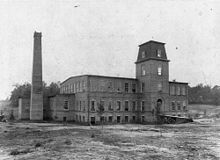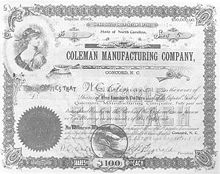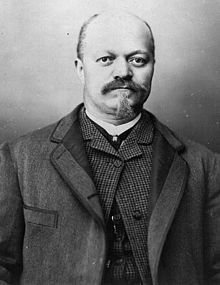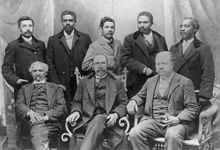- Coleman Manufacturing Company
-
The Coleman Manufacturing Company (1899-1904) was the first cotton mill in the United States owned and operated by African Americans, located in Concord, North Carolina.
The company was established in 1897 primarily by black North Carolinian capitalists. Their idea was to establish a cotton mill that would be entirely managed and operated by blacks, since all the cotton mills in North Carolina, and the South overall, would only employ blacks in menial positions.
Richard B. Fitzgerald was its first president, Edward A. Johnson its first vice-president (and was later president), and Warren C. Coleman was its first secretary, treasurer, and manager. The initial board of directors was S. C. Thompson, L. P. Berry, John C. Dancy, S. B. Pride, C. F. Meserve, and Robert McRae.
About $50,00 was subscribed, which soon increased to $100,000, by "several hundred" African Americans, mainly living in or near Concord; a few white philanthropists, such as Benjamin N. Duke who subscribed $1,000 (at six-percent interest), also invested in the capital stock of the company [1].
The mill was to have between 7,000 and 10,000 spindles, and from 100 to 250 looms, and, according to their charter, was "allowed to spin, weave, manufacture, finish, and sell warps, yarns, cloth, prints, or other fabrics made of cotton, wool, or other material" [2]. The mill had "a 270 horse power Corliss engine there and machinery that will compare favorable with any in or around Boston" [3]. Apparently, most if not all of the equipment, described as inefficient "second-hand English" equipment by one source, was purchased used by Coleman, which eventually caused production problems [4].
On February 8, 1898, the cornerstone of the 80×120 feet, three-story brick building was laid "with Masonic honors" [5]. Four-room mill houses were built by April 1900, and were rented out at about $3 per month to the employees of the mill [6]. Local black laborers and artisans initially accepted stock as payment for their work in the construction of the mill, but most soon decided to accept only money instead of more stock, and many workers quit due to the inability of Coleman to raise the necessary amount of cash at that time [4].
During the Paris Exposition of 1900, in Paris, France, the mill was touted as evidence of progress among African Americans in the United States, in an exhibit titled the "Negro Exhibit," put together by W. E. B. Du Bois, and photographs of the mill were displayed [7].
The building was finally completed in 1901, and in July of that year, Coleman informed investor Washington Duke that the mill was operating successfully. However, the mill soon began to have financial problems, mostly due to the high price of cotton, and in 1902 it was temporarily shut down [8]. In 1903, Coleman turned over management of the mill to a local white cotton merchant, Mr. White, who hired other white workers. In 1904, the company was unable to remain afloat financially, and to add to the mill's problems, Coleman died. Mainly due to these problems, the mill was advertised for sale in July 1904, and was purchased by Washington Duke for $10,000 at the "sheriff's sale." Duke sold the property in 1906 for $13,000 [9]. The original mill structure has been integrated into Fieldcrest Cannon Plant #9, northeast of the intersection of Main Street and Highway 601 South (which was named "Warren C. Coleman Boulevard" in 2001) in Concord[10].
References
- ^ Durden, Robert F. The Dukes of Durham, 1865-1929. Duke University Press, 1975. 145-147; Spahr, Charles B. America's Working People. Longmans, Green, and Co., 1900. 47.; Thompson, Holland. From the Cotton Field to the Cotton Mill. Ayer Publishing, Manchester, NH, 1971 (reprint of 1906 edition). 256.
- ^ Richings, G. F. Evidences of Progress Among Colored People. Geo. S. Ferguson Co., Philadelphia, 1905. 483.
- ^ Du Bois, W. E. Burghardt (ed.). Economic Co-operation among Negro Americans. Report of a Social Study made by Atlanta University, under the Patronage of the Carnegie Institute of Washington, D. C., together with the Proceedings of the 12th Conference for the Study of the Negro Problems, held at Atlanta University, on Tuesday, May the 28th, 1907. The Atlanta University Press, Atlanta, 1907. 159-160.
- ^ a b Thompson, Holland. From the Cotton Field to the Cotton Mill. Ayer Publishing, Manchester, NH, 1971 (reprint of 1906 edition). 257.
- ^ Richings, G. F. Evidences of Progress Among Colored People. Geo. S. Ferguson Co., Philadelphia, 1905.
- ^ Reports of the Industrial Commission, by the United States Industrial Commission. Volume II. Government Printing Office, Washington, D.C., 1901. 505-8.
- ^ Gilman, N.P. Social Economics at the Paris Exposition. Bulletin of the Department of Labor, Vol. VI, No. 34, May. Government Printing Office, Washington, D.C., 1901. 471.; Prints & Photographs Online Catalog - African American Photos for Paris Exposition. <http://lcweb2.loc.gov/pp/anedubhtml/anedubback.html>.
- ^ Thompson, Holland. From the Cotton Field to the Cotton Mill. Ayer Publishing, Manchester, NH, 1971 (reprint of 1906 edition). 258.
- ^ Thompson, Holland. From the Cotton Field to the Cotton Mill. Ayer Publishing, Manchester, NH, 1971 (reprint of 1906 edition). 259-60.; Durden, Robert F. The Dukes of Durham, 1865-1929. Duke University Press, 1975. 147.
- ^ Coleman Manufacturing. Cabarrus County NCGenWeb. <http://www.rootsweb.ancestry.com/~nccabarr/ColemanMfg.htm>; NCDOT. North Carolina Memorial Highways and other Named Facilities. 2004.
Categories:- Buildings and structures in Cabarrus County, North Carolina
- Concord, North Carolina
- African American history
- History of the United States (1865–1918)
- History of racial segregation in the United States
- History of racism in the United States
- History of the textile industry
- Companies established in 1899
- Defunct companies based in North Carolina
- Defunct manufacturing companies of the United States
Wikimedia Foundation. 2010.




